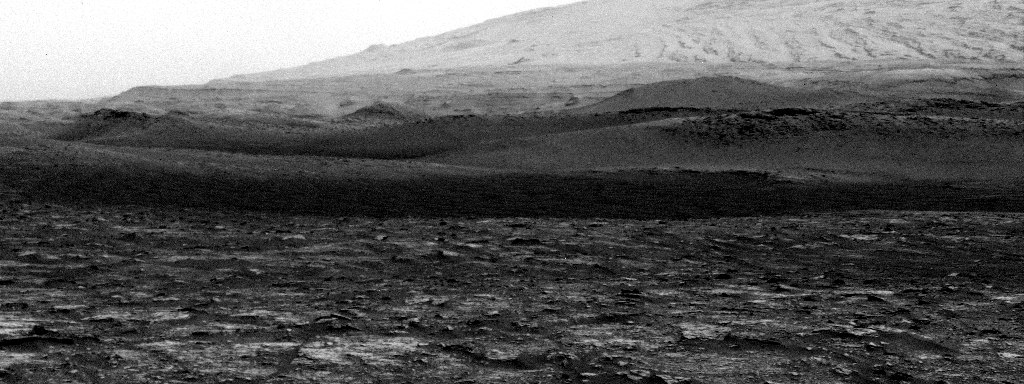Curiosity: Summer approaches in Gale crater

Mars is often a very dynamic place due to its atmosphere and how it interacts with the surface. At present, we're in the "windy season" in Gale crater. This means that we're seeing increased aeolian (meaning "related to the wind") activity at the surface. In recent sols, we've taken Mastcam images of the same surface ripples on multiple sols. We've been able to see the ripples moving from sol to sol, due to wind moving the sand grains that make up the ripples, which tells us both the dominant wind direction and how strong the wind is. Today's plan included more observations designed to look for changes on the surface and rover deck: a MARDI image of the region below the rover, to prepare for making more images of that location over the next few sols so we can look for changes, and a Navcam deck pan, to look for changes to dust and sand grains on the rover deck.
It's almost summer in Gale crater, which puts us in a period of strong surface heating that lasts from early spring through mid-summer. Stronger surface heating tends to produce stronger convection and convective vortices, which consist of fast winds whipping around low pressure cores. If those vortices are strong enough, they can raise dust from the surface and become visible as "dust devils" that we can image with our cameras. The animated GIF shows a dust devil movie we took with Navcam on Sol 2847, covering a period of about five minutes. We often have to process these images, by enhancing what's changed between them, before dust devils clearly show up. But this dust devil was so impressive that—if you look closely! - you can just see it moving to the right, at the border between the darker and lighter slopes, even in the raw images.
In today's planning, we added both a short and a long Navcam dust devil movie, which take lots of images of the same region over respectively a five or 30 minute period. These give us the most information about dust devils, such as where they initiate, how they evolve, and how much variety there is in size, dust-content, and duration. Looking at how fast they're moving and in what direction also tells us about the background wind speed and direction at their location. We also made sure to take meteorological measurements with REMS throughout each movie, in case we image a vortex that's close enough for us to also measure its pressure drop, impact on local temperatures, or even UV radiation if it's dusty enough to partially block out the Sun. Combining imaging with other observations can tell us more about the size and dust content of a dust devil and how far it is from us. We also added a five-minute Navcam dust devil survey. This takes three images in eight directions, covering the whole 360° around the rover, and helps us gather statistics on when and where dust devils occur.
We also continued to explore the clay-bearing unit, where our primary goal at present is to drill and sample material for SAM's "wet chemistry" experiment. This involves transforming less volatile organics into forms that can be detected using SAM's Gas Chromatograph Mass Spectrometer. It turned out that we weren't positioned perfectly to drill at the "Mary Anning 2" target, so we included a short drive or "bump" to put us in the right place by the next plan. In the meantime, we added three ChemCam observations of the nodular layers in the "Howwood," "Maligar," and "North Fearns" targets, plus a Mastcam image to document those targets. We also added a ChemCam RMI long-distance mosaic and a Mastcam workspace image.
Finally, the plan included our usual RAD, DAN passive and active, and REMS cadence of observations, plus cloud movies and measurements of how much dust we see above us and across the crater. The dust measurements will help us to track the regional dust activity on Mars that has been seen from the surface and orbit in recent sols.
More information: Sols 2851-2852—Working Around the Wind: mars.nasa.gov/msl/mission-upda … king-around-the-wind
Provided by NASA





















